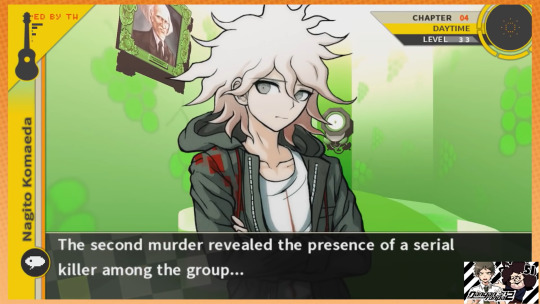#surprisingly not too many researchers are waiting for the results of this scientific survey it's just for fun
Explore tagged Tumblr posts
Text
Poll: What is, on average, the best Danganronpa chapter across the 3 mainline games?
AKA all Danganronpa murders are the same <3.
Parallels among the murders of the same chapter are listed below:
Chapter 1, AKA: "In a murder committed out of fear and panic, after dusk, in a location where the protagonist appeared shortly before, a strongly motivated individual, after taking initiative on their own, is murdered as a result of a betrayal by the protagonist's best ally, after which the corpse of the victim is found slumped on the floor and during the trial for which the blame is for a prolonged time placed on the protagonist or their ally (who was indeed involved, but ultimately is not the blackened)."
Chapter 2, AKA: "In an attempt to maintain allegiance to an important individual and to uphold a sense of honor for their Ultimate title, a capable classmate bludgeons to death the mentally strong yet physically weak (or mentally weak and physically strong) fan favorite (who therefore ends up dying too early) in a hands-on-hands physical confrontation, after which the placement of the corpse as well as the "perceived" crime scene is messed with to pin the blame on another person."
Chapter 3, AKA: "A-not-mentally-well-adjusted individual commits an immaculate and complicated double murder for a unthinkably irrational or amoral cause, which includes a body appearing at the crime scene out of nowhere in a seemingly impossible fashion, and in which one of the victims is the one who was lured out by the killer and willfully takes part in the action (but unknowing that it will result in their own murder) and in which the other victim ends up being the socially ostracized individual, simply because they happen to be at a wrong place at the wrong time."
Chapter 4, AKA: "Within a set-up for a locked room murder mystery, the good-hearted fan favorite becomes a part of a two-person life-and-death allegiance to perform a heroic act of self-sacrificial killing using an unknown murder method with the intention of getting themself killed so that everyone else may live, while one person is revealed to have had a deeper insight into the killing game for some time."
Chapter 5, AKA: "In an unsuccessful attempt to bring the killing game to its conclusion, the most malicious student of the class orchestrates an almost perfect, convoluted and seemingly unnecessarily but indeed intentionally violent murder (which serves as a way of mangling the corpse to a point where the murder method is concealed), whose solving hinges on the protagonist's new but trusted ally's confession about their not-really-consenting involvement."
Chapter 6, AKA: "After a retrospective investigation that brings to light new circumstances about the game's setting as well as its previous events, an existential crisis consumes the remaining survivors as the identity of the class and the killing game itself is revealed, during which Junko Enoshima appears (of course), and which ends with the true protagonist killing the mastermind in order to seek redemption, freedom and hope for their classmates.
P.S. This whole thing was primarily inspired to by my desire to prove Nagito's assumptions from chapter 4 wrong:





Most of these are fortunatelly not true when we also take V3 into account: while Rantaro was important, he wasn't stabbed; a serial killer was revealed in the third chapter, not the in the second; and I wouldn't exactly classify chapter 4 murder as a suicide in either sdr2 or v3 (though we DID have two people playing Russian roulette in the Funhouse, yikes). All in all, the murders wouldn't have been nearly as shocking if they correlated with what had been already pointed out in the second game before, so I'm not really surprised that there ended up being other similarities among the murders.
That's all, thank you for reading <3
#thank you in advance to anyone who voted#if you're unsure of what to pick just go based on vibes#surprisingly not too many researchers are waiting for the results of this scientific survey it's just for fun#the idea to compille all the parallels in the chapters of the same number has been occupying my head for a long time#so Im glad I was able to find quite a satisfying number of them Id say#really highlights how good dr's writing can be sometimes#chapter 4 is probably my favorite Id say on average it has produced the biggest amount of tears 🥲🥲🥲#sorry in advance for spamming the main character tags I'm not 100% sure whether this is fit to be main char tagged#txt#drv3#sdr2#danganronpa#kokichi ouma#nagito komaeda#shuichi saihara#hajime hinata#kaede akamatsu#mahiru koizumi#chihiro fujisaki#kirumi tojo#tsumugi shirogane#kaito momota#sakura oogami#gundham tanaka#tenko chabashira#angie yonaga#makoto naegi#kyoko kirigiri#leon kuwata#💜
104 notes
·
View notes
Text
The Language Learning Curve: What’s the Best Way for You to Improve Your Language Skills
Becoming fluent in a new language is a journey… and in my research with language learners I’ve discovered a “language learning curve” that most people follow. Before I share that, here’s how the language learning journey went for me. After 5 years of learning Spanish at school, I was only able to remember the bizarre phrase “tengo diez peces” (“I have ten fish”). To be honest, when I started Spanish, I honestly never thought that I would get much further than “buenos días”, so maybe talking about fish was a step forward from that! As it turned out, I returned to Spanish as an adult in evening classes at university, and then jumped between various self-study courses before moving to Spain for an eight week language course. I experimented with any and all materials available, and (perhaps most importantly) moved into an all-Spanish speaking flat within a month or so. I spent the next two years in Spain, and the year after that in Colombia. I remember watching Spanish TV on the first night after moving to Spain (Valencia), and wondering if I would ever understand what they were saying. After a few months in Spain, I was able to work my way through a newspaper (El País - probably not the easiest one for learners!), stopping every second word to look something up in the dictionary, taking one hour to get through an article. With listening, for a while I could only pick out words and phrases. Later, I started to connect the dots - moving from getting the gist of something to understanding subtleties of conversation. I remember the feeling of frustration that everyone passes through when they can understand more than they can say, and then the joy of finally being able to express myself as I wanted to. Becoming a confident Spanish speaker took me a long time, and it was anything but a linear process. I certainly haven’t finished learning, and I hope I never do. Fast-forward a few years, and I became curious to understand whether other people’s experiences learning languages were the same as mine. I run a website for Spanish learners, Spanish Obsessed, with my Colombian partner Lis, and we asked our readers to share their experiences learning Spanish. We created a survey asking for responses around various data points, in the hope of piecing together the typical language learning curve. We were to delighted to get over 500 responses! Based on these we derived a few interesting insights into how people learn a new language. Before I get into the data, a quick caveat: This is not a strictly scientific, controlled study. Responses were self-reported, and while the people responding to the survey come from a variety of backgrounds, may not be completely representative of all language learners.
The Language Learning Curve: How Long Do Most People Take to Learn a Language?
We asked people how long they had been learning Spanish, and what level they thought they had reached. Here’s what we found: Digging deeper into the chart above, we can see:
For the typical language learner, it takes around 18 months to reach the “pre-intermediate” stage, or 25% of the total time they’ll spend studying to reach near-native level. This is the honeymoon phase of language learning, where everything is new, motivation is high, and progress is quick.
Things start to slow down between “pre-intermediate” and “intermediate”. This is where learners move from fumbling their way around some basic phrases to stringing sentences together. It’s also marked by a big increase in comprehension. Around two thirds (66%) of the time spent learning a language is spent here.
Once you make the jump to upper-intermediate, it becomes easier and things speed up. The hardest jump is between pre and upper-intermediate.
Reaching a native level of proficiency takes a long time… Our advanced learners have been studying an average of six years. Initially, I thought this seemed like far too long. However, this is the average, across a large group of learners. They are a mix of people, including casual learners.
How Much Time Per Week do You Need to Learn a New Language?
We also asked participants how long they spent on Spanish each week:
Motivation seems to be at its highest at either end of the language learning spectrum. Beginners are filled with,a hunger for the language. Likewise, the most advanced learners spend a long time each week on their Spanish.
There’s a definite wane in time spent studying once learners get over their initial honeymoon period. Study time drops from nearly six hours to around three hours per week, as learners figure out that they’re in this for the long haul, and the quick early gains start to subside.
High level learners still spend a long time studying Spanish, using a mix of activities, including listening, speaking and reading. This perhaps reflects their consistency and continued motivation. Good things come to those who wait (and work for it!).
What Language Skills are the Easiest to Learn?
Respondents also rated a variety of language skills (such as speaking and reading comprehension) between 1 (easiest) and 5 (most difficult). Not surprisingly, everything gets easier as learners improve. Here’s what we found overall:
Grammar is hardest for complete beginners, but quickly becomes one of the easiest skills. It seems that once beginners have an idea of the absolute basics, grammar quickly falls into the background.
Interestingly, speaking skills (both fluency and accuracy) are at their most challenging around the elementary/pre-intermediate levels, while listening comprehension is actually slightly easier. This reflects that feeling that learners go through of understanding more than they are capable of producing. The good news is that this gets easier over time.
Speaking was rated as the hardest skill for all levels, while reading was the easiest. No surprises here!
The 4 Stages of Language Learning
Based on our findings as well as our own experience, we’ve broken down learning a language into four stages. We’ve included an approximate time-frame for each stage based on our findings, however remember that this is an average and it’s possible to learn a language much faster with the right approach and motivation. Here’s what you can expect learning a language to native level fluency:
Stage 1: Beginner - Elementary (0 - 6 months)
At this stage, you’re full of enthusiasm for the language. Everything’s new, and you can immediately see how to use phrases and vocabulary that you learn. You’re in the honeymoon period - you have time and energy to devote to this, and as a result progress is quick as you learn the easy “low hanging fruit” of the language. “Grammar” is a large, scary concept, but you’re not too worried about that for now. Everything’s difficult, but you’re making rapid progress so feel good. Focus areas for beginners:
Enjoy the quick progress you are making, and use this time to start building a language learning habit.
Understand that you are learning a lot, quickly, but that things will get harder.
Decide now whether or not you want to commit for the long term.
Stage 2: Elementary to Pre-Intermediate (6 months - 1 year)
This is the stage that sorts the wheat from the chaff. Those who took up learning Spanish as a fad are starting to drop off, and you realise that you are in this for the long-haul. You have a choice to make: learning this language is now either a labour of love or a struggle. You’ll find that your motivation starts to wane, and the time you spend on Spanish nearly halves. Progress slows down as the easy wins available to beginners dry up. Speaking starts to become a major frustration, as you realise how far your tongue is behind your ears. This is one of the hardest points to break past in learning a language. Focus areas for pre-intermediate language learners:
Motivation and persistence are key here. Although it now seems more of a struggle, if you revisit your initial motivation that will keep you going.
Choose to view this as a labour of love, rather than a struggle.
Understand that this is, in many ways, the hardest point in the language learning curve. Things will only get easier, and you will only get better from this point!
Stage 3: Pre-Intermediate to Intermediate (2 - 3 years)
Good things come to those who persevere! This is the steepest part of the learning curve, but if you are able to make it to intermediate level there’s a good chance you can keep going. You’ll have a decent enough grasp of grammar and base vocabulary to understand 80% or more of what you hear and read. Speaking skills (both fluency and accuracy) show marked improvements as you reach an intermediate level, and you can start having more in-depth conversations. Listening is also a lot easier at intermediate level, and you’ll enjoy your interactions a lot more at this stage. Focus areas for intermediate language learners:
Have as many real conversations with real people as you can.
Increase your input as much as you can - now’s the time when you should look to watch Spanish TV, read the newspaper in Spanish, and change your Facebook to Spanish (if you haven’t already!).
Stage 4: Upper Intermediate and Beyond (3 years +)
After 3 years (or maybe sooner, of course!), you’ll start to break into fluency. Everything becomes easier, and you start to enjoy Spanish and live in it, rather than view it as an object to be studied. You can have fulfilling conversations with native speakers, you can understand a variety of types of Spanish, and as a result of this spend more time in the language. This has the happy consequence of further improving your Spanish, which becomes a loop: the more you enjoy Spanish, the more time you spend immersed in it, and the better you become. From this point onwards, it’s up and away! Focus areas for advanced language learners:
You’ll be finding Spanish really enjoyable now, so make sure that you keep trying to bring Spanish more into your life. The more immersion the better, and you don’t have to go to a Spanish speaking country to do this.
You don’t need to compartmentalise your time into “study time” any more. Look for ways to integrate Spanish into your life, without necessarily having to set aside an hour each day specifically for the purpose
Where are You on the Language Learning Curve?
Where would you put yourself on the language learning curve? How long have you been learning the language? Do my findings resonate with what you’ve found in your language learning journey? Let me know in the comments - I’ll spend time getting back to each of your comments, so jump right in!
The post The Language Learning Curve: What’s the Best Way for You to Improve Your Language Skills appeared first on Fluent in 3 months - Language Hacking and Travel Tips.
Shared by learntospeakspanishquickly.com: http://ift.tt/2wB3nmo from Blogger http://ift.tt/2uy9kDi
0 notes
Text
New Post has been published on
New Post has been published on http://gogetthelook.com/2017/02/28/natural-male-enhancement-how-to-enlarge-your-penis-size-naturally/
Natural Male Enhancement: How To Enlarge Your Penis Size Naturally
Product Description This book will teach you how to enlarge your penis size Naturally in just three simple steps that i found and it works out for me and all my friends. just grab your copy and understand the 3 secrets and continue following the Volume to understand more and get your desired result.
Product Description Gain SIZE, LENGTH, GIRTH increase pleasure for you and your partner. This is one of the strongest male enhancing supplement available, no need to exceed the dosing of 2 caplets a day. Get the most intense male benefits you could have imagined from a natural supplement! Male RX has been formulated to deliver powerful results quickly. This male enhancement powerhouse gives you the male benefits you want WITHOUT a prescription or unwanted side effects. Just two caplets a day delivers the results you desire! Male RX male enhancement is an herbal alternative to those "blue pills" Formulated with a scientifically balanced formula of herbs, herbal extracts, vitamins, minerals and other nutrients. Helps increase the blood flow to restore male strength, sensitivity and seminal fluid production. Finally a male enhancement pill formulated with the added benefits of ENERGY & FOCUS: This male enhancer has been formulated to provide "extra" benefits all men need. Gain not only libido and stamina in the bedroom but extra energy & focus as well. These herbal ingredients bring a healthy burst of energy to your day without the jitters. 90-DAY 100% MONEY BACK GUARANTEE. We're so confident that you'll love our men's libido enhancer and male booster that we'll refund every penny if you don't like it. You can even return the empty bottle! No Risk to you. Manufactured to the highest standard in a GMP (good manufacturing practices) and proudly made in the USA. We only use high quality clinically-tested ingredients, all of which are condensed into easy to swallow caplets.
Price: $39.95
Increase Blood Flow thereby maximizing erecting quality and size.
Maximize your performance by gaining male stamina for all night performance.
Regain those feelings of intimacy you remember. Boost libido and mood.
Get real results real fast! Don't wait until it's too late, perform when you need it
GET FAST RESULTS WHEN YOU NEED THEM MOST!
7 Natural Foods that Really Helps in Sexual Health | Male Enhancement
youtube
http://www.nutritionforest.com/male-enhancement.html
http://www.nutritionforest.com
Male Enhancement Ultimate Men’s Performance
There are large number of men who are unable to satisfy their sexual desire. Male sexual arouse is very complicated process which involves the role of brain, hormones, emotions, nerves, muscles and blood vessels. Problem with any of these can obstruct the way of erection which leads to erectile dysfunction.
Many people are afflicted with erectile dysfunction, reason being stress, anxiety, depression, lack of proper blood flow and psychological causes. Due to erectile dysfunction they don’t get satisfactory intercourse with their partner. Therefore Nutrition Forest brings a supplement, Male Enhancement Ultimate Men’s Performance for males who are above 18 so that they can prevent erectile dysfunction and can enjoy complete manhood.
Male Enhancement Ultimate Men’s Performance has been manufactured with the purpose to enhance stamina and erection quality. This supplement comprises ingredients which help to maximize the size, length and girth of penis. These ingredients help to maintain sufficient flow of blood which leads to erection, boosts stamina and enhances the performance.
The subject of male enhancement isn’t something which many males are more comfortable talking about. On the other hand, lots of men search for tips on how to enhance their sexual capabilities on a regular basis. Irrespective of your age, you might find that a male enhancement product will help you to maximize and boost sexual functionality. There are lots of male enhancement products that exist across the counter or have the potential to deliver the results within 20-30 minutes after consuming them. If you are planning to help boost your vitality, hold much longer erections, attain more effective orgasms and improve your sexual urge, then you definitely may prefer to think about trying a purely natural male enhancement product.
male enhancement pills best male enhancement pills natural male enhancement best male enhancement dick pills male enlargement pills penise enlargement male enhancement pictures dick enlargement male enhancement products male enhancement exercises male enhancement surgery enlargement pills extenz male enlargement natural male enhancement pills over the counter male enhancement top male enhancement pills make your dick bigger penus enlargement pro solution enhancement pills best male enhancement pill male enhancement pills that work Healthy Libido erectile dysfunction semen quality Enhances stamina testosterone hormone get stronger, harder and longer panis Helps in ejaculation biggest dick dick sizes big pennies the biggest dick panis size how to have a big dick
The most built into misconceptions about cosmetic surgery are addressed poor Existence Stage Personal Enhancement.
1. Women should not get it until they are a minimum of 60: Waiting until a lady is publish-menopausal can dramatically – and negatively – alter the nature from the surgical result. The older patient too frequently ends up by having an “overdone” look where the skin must colouring very tight to have contour enhancements that might have been easier maintained when the procedure have been done at a more youthful age. Undertaking less-drastic procedures pre-menopause enables leads to be kept longer and, in lots of conditions, to look natural and consistent with a ladies overall look.
2. It is just for that wealthy: Statistics in the American Society of Cosmetic Surgery reveal that most patients undergoing this are middle-class patients using their very own disposable earnings. Actually, the median earnings for patients who undergo this is rough $ 80,000. Many cosmetic surgeons offer a number of flexible financing options, and non-surgical treatments such as the injection of Botox treatment and employ of fillers like Juvéderm is surprisingly cost-effective — oftentimes costing nothing more than exactly what a lady can count on paying for hair coloring or salon treatment.
3. It is just for ladies: Men presently represent 15 % from the final amount of patients undergoing plastic surgery, several that’s been continuously growing in the last decade. It isn’t surprising: Men may need to look their finest inside a competitive employment market. Consequently, more people entering their 40s and 50s are trying to find the use of non-surgical treatments like using Botox treatment, neurotoxin or fillers to refresh the look of them. Males are also growing at ease with other surgical procedures including management of enlarged hereditary breasts (gynecomastia), liposuction to deal with “tops.” and nose reshaping or nasal surgery.
4. It is just for that vain: Many patient satisfaction surveys and excellence of existence outcome research has proven that patients enjoy genuine enhancements in body image along with greater satisfaction with a person’s position in reality after plastic surgery. It is a cliché. However recognised frequently state that it does not add many years to your existence, however, it can also add presence for your years. The quality of existence, not vanity, may be the primary decision-making factor for most patients.
5. It requires a lengthy time for you to get over it: Advances in surgical technique, anaesthesia methods and discomfort control imply that, oftentimes, patients no more possess the downtime connected with dealing with general anaesthesia. The incidence of vomiting and nausea after surgical treatment is markedly decreased and people are frequently capable of getting back to their daily routines more rapidly. While surgical healing takes time, most sufferers can get to go back to normal activities in a couple of days.
6. Breast enhancement is harmful: Breast enlargements have most likely been probably the most completely studied device within the good reputation for American medicine. While no operation is without risks, the potential risks and possible complications of breast enhancement surgery happen to be clearly defined. People are obtaining the message: Since 2008, breast augmentation surgery continues to be the most typical cosmetic operation within the US States.
7. Botox treatment is really a harmful contaminant: Botox treatment comes from the contaminant secreted by particular bacteria. While massive doses of the contaminant may cause the disease to build up, the dose degree of Botox treatment treatments is minimal, and also the start of the illness has not been seen following the administration of Botox treatment. Indeed, Botox treatment has the best safety profiles associated with a medicine which has had you been developed.
8. All aesthetic or plastic surgeons are cosmetic surgeons: Many specialities offer plastic or plastic surgery services, but not every one of these surgeons have gone through the same degree of training as Board Certified cosmetic surgeons. People are always advised to determine the credentials and qualifications of the surgeon and really should identify (a) whether that doctor has earned board certification through the American Board of Cosmetic Surgery, and (b) if the surgeon has rights to do cosmetic surgical treatments inside a hospital setting. Getting hospital rights subjects the cosmetic surgeon to see review, ongoing credentialing, medical education along with other monitoring that doesn’t exist when the cosmetic surgeon are operating in a non-hospital facility.
9. Effort and improving a person’s diet delivers surgical-type results: Focus on diet, exercise, sun avoidance and diet are critical areas to possess built-into a person’s personal lifestyle before elective plastic surgery is recognized as. You will see occasions when, despite an individual’s best efforts to stay in keeping with the greatest beliefs in diet and workout, regions of contour deformity will build up that may just be cured with it. It ought to be stated, though, that people are frequently better offered with an expert in nutrition and the private trainer just before undergoing it instead of getting it first after which contacting a trainer or nutritionist.
For more information please visit here. Sydney Plastic Surgery
0 notes